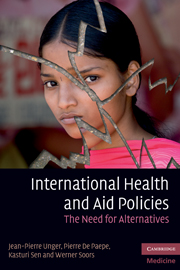Book contents
- Frontmatter
- Contents
- Preface
- Biographies
- Notices
- Acknowledgements
- List of abbreviations
- Reviews
- Introduction: Overview and purpose
- Section 1 Paradigms of international policies
- Section 2 The failure of the aid paradigm: poor disease control in developing countries
- 3 Why do disease-control programmes require patients in health services to succeed in delivering? The case of malaria control in Mali
- 4 How do disease-control programmes damage health care delivery in developing countries?
- 5 Privatization (PPM-DOTS) strategy for tuberculosis control: how evidence-based is it?
- Section 3 Impact of international health policies on access to health in middle-income countries: some experiences from Latin America
- Section 4 Determinants and implications of new liberal health policies: the case of India, China and Lebanon
- Section 5 Principles for alternative, publicly oriented health care policies, planning, management and delivery
- Section 6 A public health, strategic toolkit to implement these alternatives
- Conclusions
- Glossary
- Index
- References
4 - How do disease-control programmes damage health care delivery in developing countries?
Published online by Cambridge University Press: 06 December 2010
- Frontmatter
- Contents
- Preface
- Biographies
- Notices
- Acknowledgements
- List of abbreviations
- Reviews
- Introduction: Overview and purpose
- Section 1 Paradigms of international policies
- Section 2 The failure of the aid paradigm: poor disease control in developing countries
- 3 Why do disease-control programmes require patients in health services to succeed in delivering? The case of malaria control in Mali
- 4 How do disease-control programmes damage health care delivery in developing countries?
- 5 Privatization (PPM-DOTS) strategy for tuberculosis control: how evidence-based is it?
- Section 3 Impact of international health policies on access to health in middle-income countries: some experiences from Latin America
- Section 4 Determinants and implications of new liberal health policies: the case of India, China and Lebanon
- Section 5 Principles for alternative, publicly oriented health care policies, planning, management and delivery
- Section 6 A public health, strategic toolkit to implement these alternatives
- Conclusions
- Glossary
- Index
- References
Summary
Adapted from: Unger J.-P., De Paepe P., Green A. A code of best practice for disease control programmes to avoid damaging health care services in developing countries. Int J Health Planning and Management 2003; 18: S27-S39.
Introduction
In 2002 already, Oxfam had demanded ‘programmes which are designed for and implemented to strengthen existing health systems, in order to ensure effectiveness and sustainable impact’ (Oxfam, 2003). The dilemma of picking up the pieces of decades of neglect and in some cases of devastation remains. Thus the question facing us now is how? To answer this, we re-examined the several possibilities starting from a managerial perspective in order to try and gauge the feasibility of effective integration.
To do this, based on a review of the literature, we first examined mechanisms whereby integrated disease-control activities can jeopardize accessibility and acceptability of general health care delivery, resulting in low service utilization and low programme target detection rates. We then put disease-control programmes into three categories and assessed the impact of each on local health care facilities. Finally, we suggest a series of measures designed to help aid agencies and national governments support local health care infrastructures or, at least, to avoid damaging them (details are given in Section 5, Chapter 16).
In this chapter, integration is defined as a process where disease-control activities are functionally merged or tightly coordinated with polyvalent health care delivery. However, another definition is sometimes used in the technical literature.
- Type
- Chapter
- Information
- International Health and Aid PoliciesThe Need for Alternatives, pp. 48 - 56Publisher: Cambridge University PressPrint publication year: 2010



